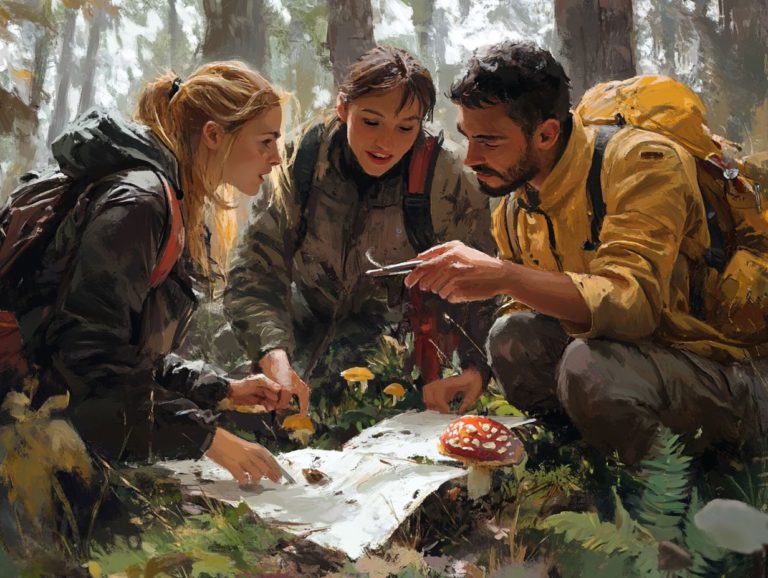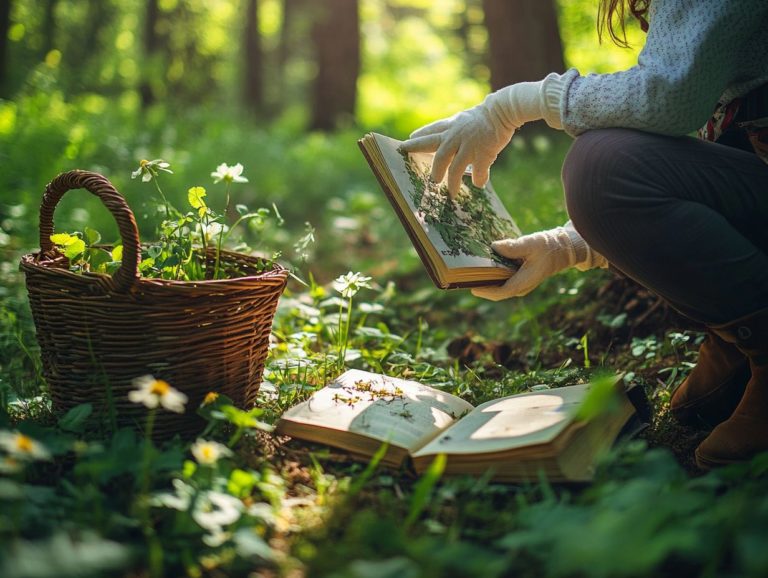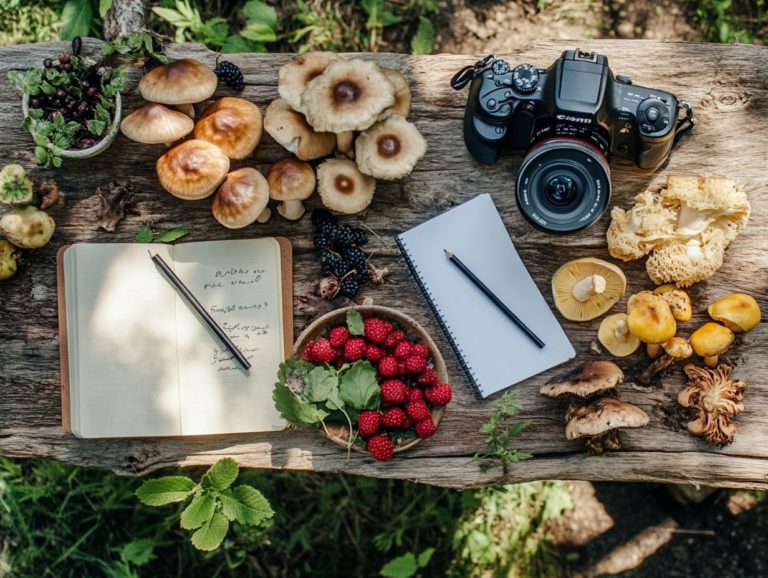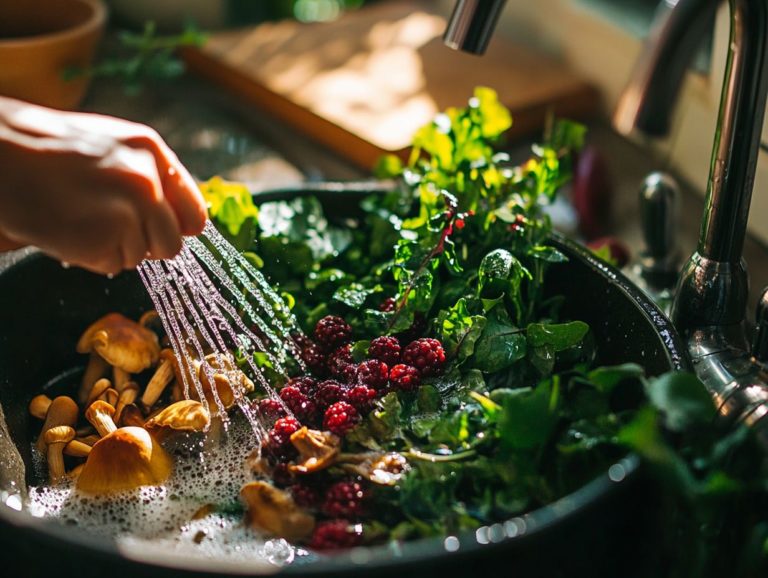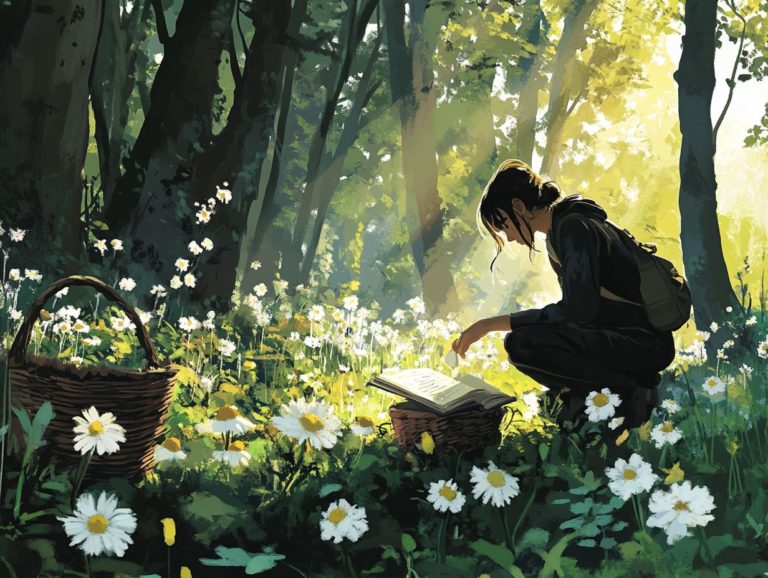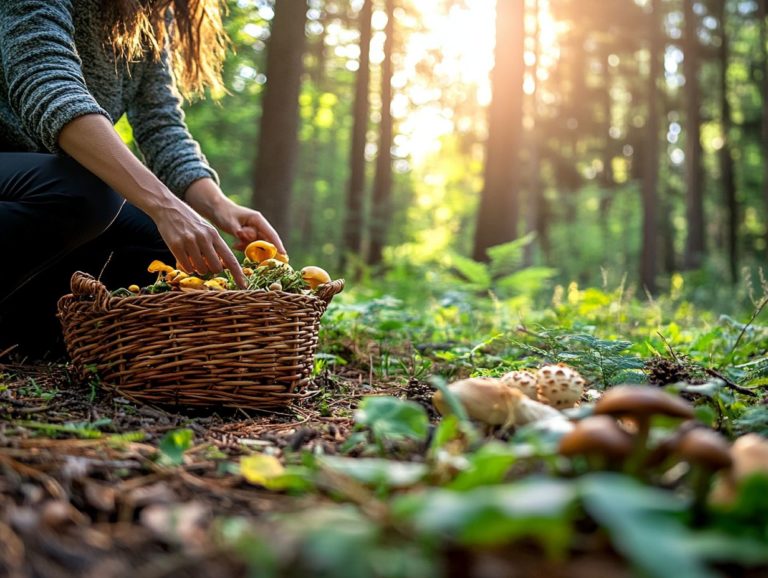What Are the Most Essential Foraging Skills?
Foraging means searching for and gathering wild food items. It transcends mere trendiness; it s a profound opportunity to connect with nature and unearth the abundance that surrounds you.
This article delves into the many benefits of foraging, highlighting how it can enhance your health while promoting environmental sustainability. You ll acquire essential skills, such as identifying edible plants and fungi, along with practical tips for safely navigating the great outdoors.
Discover responsible foraging practices and access valuable resources that will seamlessly integrate you into the vibrant foraging community.
Don t miss out join a guided foraging walk today!
Contents
- Key Takeaways:
- Benefits of Foraging
- Essential Foraging Skills
- Practicing Sustainable Foraging
- Foraging Resources and Communities
- Frequently Asked Questions
- Curious about the top skills for foraging?
- How do I identify edible plants and berries while foraging?
- What are some tips for hunting and trapping animals while foraging?
- How can I build a basic shelter and fire while foraging?
- What are some methods for water purification while foraging?
- How can I improve my navigation skills while foraging?
Key Takeaways:

- Knowing how to identify edible plants and fungi is crucial for successful foraging. Proper identification helps avoid harmful or poisonous plants.
- Harvesting and preparing foraged foods requires knowledge and technique. Improper handling can lead to food poisoning or contamination.
- Practicing sustainable foraging is important for our environment’s health and the continuation of foraging resources. This includes responsible harvesting and leaving no trace in the wild.
What is Foraging?
Foraging is an invigorating practice where you search for and gather wild edibles like plants, mushrooms, and insects. It s not just an enjoyable outdoor activity; it s also an invaluable survival skill that allows you to connect with nature while sourcing food options directly from your local environment.
As its popularity surges, foraging has become a cornerstone of self-sustaining lifestyles for many, offering unique culinary experiences and access to nutritious foods rich in vitamins and minerals.
Historically, foraging has been essential for human survival, deeply embedded in various cultures worldwide. Many indigenous communities thrived by relying on the diverse edible flora and fungi around them, cultivating a profound respect for the land and its gifts.
Today, each region boasts a distinct selection of wild edibles, from dandelion greens to chanterelle mushrooms, all offering impressive health benefits. These foraged delights not only supply vital nutrients but also align perfectly with eco-friendly living practices.
If you re eager to embark on your foraging adventure, consider starting with guided foraging walks or workshops. This ensures you learn proper identification and safe harvesting techniques. Additionally, research local foraging regulations to practice responsibly and sustainably.
Benefits of Foraging
Foraging opens up a treasure trove of benefits! It elevates your health, champions environmental sustainability, and nurtures a sense of community learning.
By immersing yourself in foraging activities, you enhance your nutritional awareness through access to a variety of nutrient-dense wild edibles, all while cultivating self-reliance and a connection to local flora.
Foraging also helps you develop outdoor skills and appreciate the environment, transforming it into a holistic practice that enriches both your personal well-being and the ecological balance around you.
Health and Environmental Benefits
Don t miss out on the incredible health and environmental benefits waiting for you! The health and environmental benefits of foraging are truly remarkable, granting you access to wild edibles that are full of nutrients and hold potential medicinal properties. By embracing a variety of foraged foods, such as wild mushrooms and edible plants like dandelion leaves and elderberries, you can enrich your diet with distinctive cooking adventures while supporting sustainable gathering practices that nurture local ecosystems.
These foraged gems are often loaded with essential vitamins and minerals think vitamin C, iron, and antioxidants that can significantly enhance your overall health and boost your immunity. Foraging helps you appreciate local biodiversity, deepening your connection to the environment as you learn to identify and respect various plant species.
Practice responsible foraging techniques to minimize your impact on local habitats, ensuring these precious resources remain available for future generations. This harmonious relationship between foragers and nature helps local ecosystems stay healthy and allows communities to flourish both nutritionally and ecologically.
Essential Foraging Skills
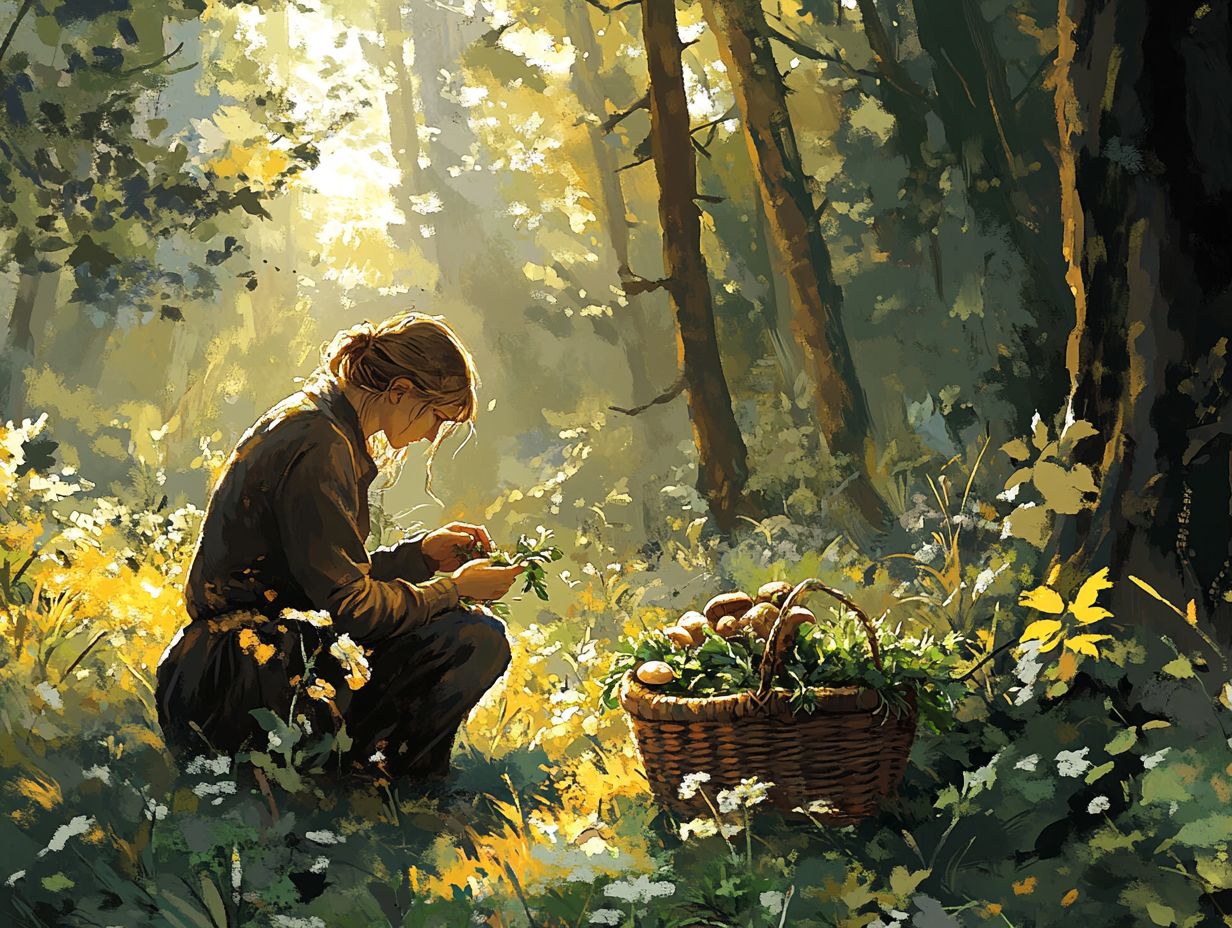
Mastering essential foraging skills is crucial for anyone keen on gathering wild edibles. This encompasses vital survival skills, such as identifying various plants and mushrooms, employing effective harvesting techniques, and understanding what beginners should know about foraging and utilizing the right foraging tools.
Familiarity with local flora, including delectable species like wild asparagus and stinging nettles, paired with practical expertise in mushroom hunting, give you the power to make informed decisions while foraging. This knowledge ensures safe consumption and enhances your enjoyment of the diverse edible treasures that nature has to offer.
Identifying Edible Plants and Fungi
Dive into the adventure of identifying edible plants and fungi! Identifying edible plants and fungi is an essential skill for you as a forager, requiring careful observation and a solid understanding of local flora to discern between safe and toxic species.
As you embark on your foraging adventures, it’s vital to familiarize yourself with common species like chanterelles and morels. These mushrooms possess unique characteristics distinct colors and shapes that help you differentiate them from their poisonous counterparts.
Relying on trusted resources, such as field guides and reputable online forums, will provide you with the essential visuals and descriptions needed to enhance your ability to identify these plants accurately.
Participating in community learning opportunities, like foraging workshops or local groups, can significantly boost your confidence and skills. Sharing experiences and knowledge with others often leads to a richer understanding of sustainable foraging practices.
Harvesting and Preparing Foraged Foods
Effective harvesting techniques are crucial for your foraging adventures, ensuring that you gather foraged foods ranging from edible flowers to insects and various plant parts sustainably. By understanding the cambium layer of pine trees, which is a thin layer of living tissue in trees that can be eaten, you can uncover additional edible resources. Knowing how to cook insects like crickets can significantly expand your nutritional options from nature’s bounty.
Foraging not only elevates your culinary experience but also deepens your connection with the environment. Ethically harvesting means recognizing the delicate balance of ecosystems and steering clear of overharvesting.
You can apply various cooking methods to the diverse array of foraged foods. For example, saut ing wild greens can amplify their flavors, while roasting or frying insects such as mealworms can transform them into crispy, nutritious snacks.
By harnessing the full potential of plants utilizing roots, stems, and leaves you can create unique dishes that promote using everything you can from what you gather. This encourages you to develop creative recipes that celebrate the abundance of nature, making every foraging expedition a delightful culinary journey.
Navigation and safety in the wild are crucial for you as someone who searches for wild food. Understanding the landscape and mastering the right outdoor skills can mean the difference between a delightful foraging adventure and a dangerous situation. Utilizing the right resources, such as what resources can help me with foraging, can enhance your experience significantly.
It s essential to familiarize yourself with local flora and fauna, seek guidance from resources like the county extension office, and practice safety protocols. This ensures your foraging expedition is both successful and enjoyable.
Investing time in honing your navigation skills is key, particularly when it comes to reading maps and using compasses. Staying aware of weather conditions is equally important, as sudden changes can create risks, especially in unfamiliar areas.
Recognizing potential hazards like slippery terrain, wild animal territories, or poisonous plants is vital for your safety. Additionally, learning what to look for when foraging can enhance your skills. Numerous resources, such as online courses, community workshops, and outdoor survival training sessions, can significantly boost your foraging expertise.
By embracing these tools, you can relish the thrill of foraging while keeping risks at bay, allowing you to fully enjoy nature’s bounty.
Practicing Sustainable Foraging
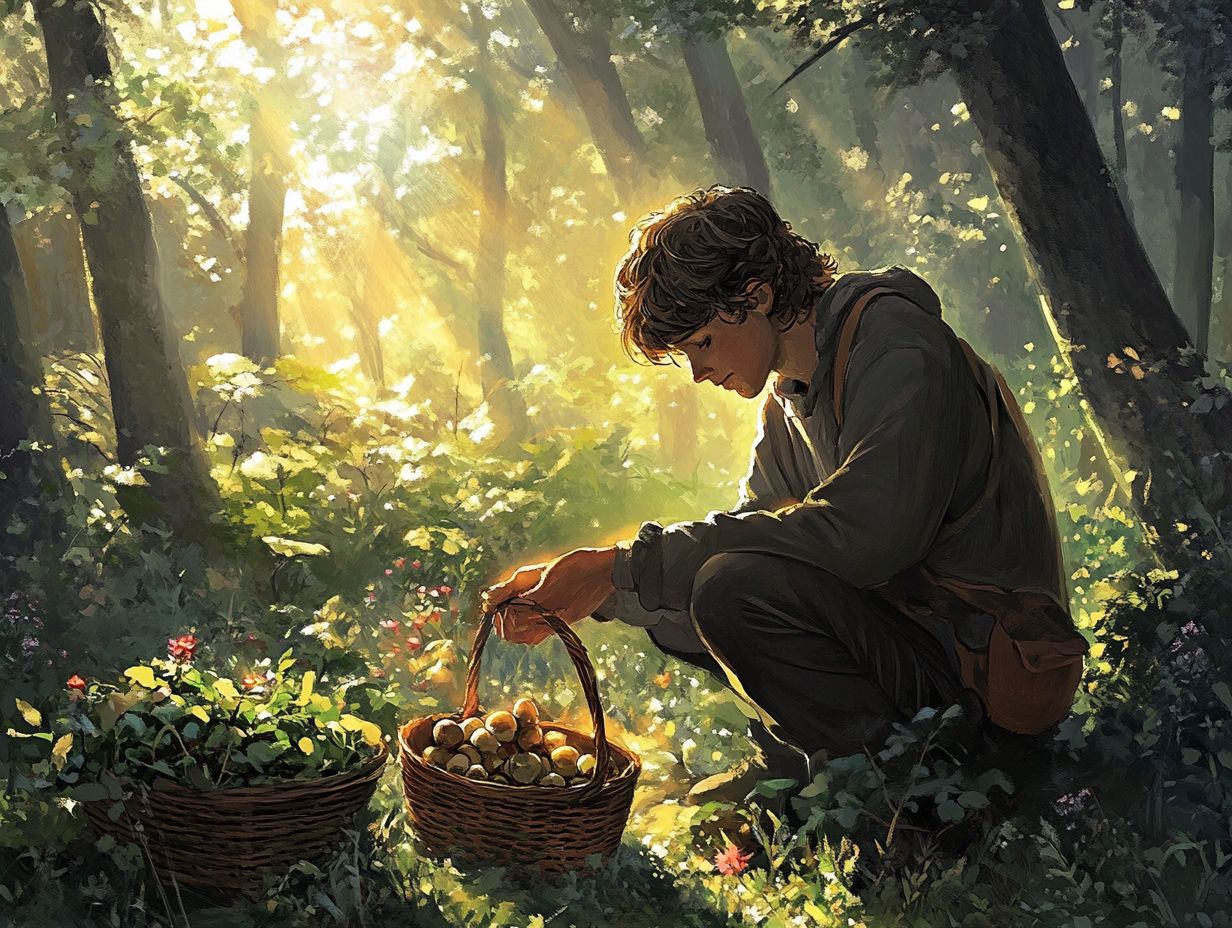
Practice sustainable foraging to protect the environment and ensure wild edibles for future generations.
By adhering to foraging ethics like minimizing your impact on ecosystems and respecting local wildlife you cultivate a responsible mindset that benefits both you and the environment.
These principles enhance your foraging experience and contribute to a healthier planet.
Responsible Foraging Practices
Responsible foraging practices are essential for enjoying wild edibles while helping local ecosystems thrive. By following foraging ethics like only taking what you need and accurately identifying edible species you contribute to sustainable gathering and foster a conscientious foraging community.
Before harvesting, assess the health of plant populations by observing their abundance and vitality. This helps plants thrive for future foragers and preserves biodiversity in the area.
Ethical foragers respect private land and existing regulations while interacting with local ecology. By embracing responsible practices, you play a role in maintaining a balanced ecosystem and enhance your own safety by being aware of potential hazards associated with wild edibles. This mindfulness enriches the foraging experience for everyone.
Foraging Resources and Communities
A rich tapestry of foraging resources and communities awaits those eager to explore wild edibles. From comprehensive guides and insightful books to esteemed organizations like the Indiana Mycological Society and Willow Haven Outdoors, the opportunities are abundant.
By immersing yourself in these community learning experiences, you deepen your understanding and cultivate meaningful connections with fellow enthusiasts who share your passion for foraging and the great outdoors.
Join a local foraging group today and start your foraging journey now!
Books, Websites, and Local Groups
Explore the world of foraging! A diverse array of books, websites, and local groups awaits your exploration, serving as helpful tools for the aspiring forager. These guides provide key information on identifying edible plants and mushrooms while sharing enriching community foraging experiences.
Often adorned with detailed illustrations, nutritional information, and tempting recipes, these resources become critical tools. They help you delve deeper into the realm of wild edibles.
Connecting with local groups immerses you in organized foraging outings and workshops. You ll gain hands-on experience and valuable tips from seasoned foragers.
Networking within these communities helps you exchange knowledge and personal stories, empowering you to build confidence and refine your techniques. Online forums and social media platforms further enrich your experience, providing an ongoing dialogue about seasonal trends that keeps you informed and inspired on your foraging journey.
Frequently Asked Questions
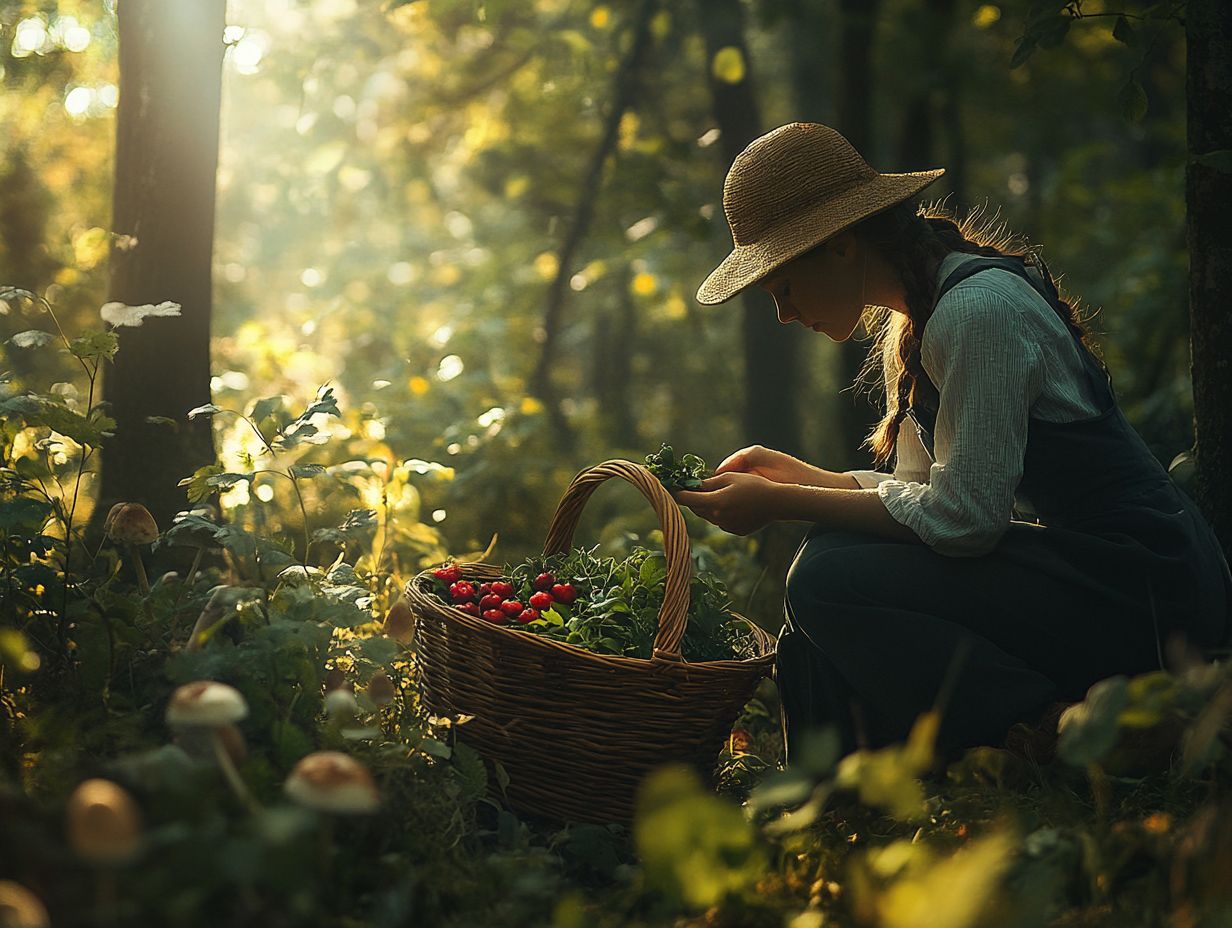
Curious about the top skills for foraging?
The most essential foraging skills include identifying edible plants and berries, knowing how to hunt and trap animals, building basic shelters and fires, water purification, and understanding what equipment you need for foraging.
How do I identify edible plants and berries while foraging?
It is important to research and become familiar with the different types of plants and berries that are safe to eat in your area. Look for visual cues such as color, smell, and texture. It is also helpful to learn from someone experienced in foraging or to take a class.
What are some tips for hunting and trapping animals while foraging?
First, it is important to obtain the necessary permits and follow all hunting and trapping regulations in your area. Next, learn about animal behavior and their habitats to increase your chances of success. Lastly, practice proper techniques for setting traps and hunting safely.
How can I build a basic shelter and fire while foraging?
Knowing how to build a shelter and start a fire are crucial skills for survival in the wilderness. Look for natural materials such as branches, leaves, and rocks to construct a shelter. For starting a fire, gather dry tinder and learn different methods for creating sparks or friction to ignite it.
What are some methods for water purification while foraging?
Water is essential for survival, but it may not always be safe to drink in the wild. Boiling water is the most effective method for purification, but it is not always possible. Other methods include using purification tablets, filtration systems, or natural methods such as solar stills or charcoal filtration.
In order to navigate while foraging, it is important to have a basic understanding of using a map and compass. It is also helpful to learn how to read natural signs such as the sun, stars, and landmarks. Practice these skills in different environments to become more confident in your ability to navigate.
Start your foraging adventure today and connect with nature in a whole new way!

